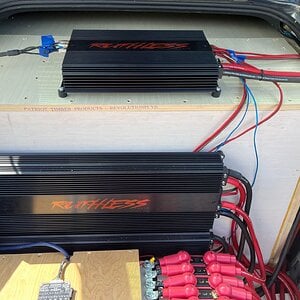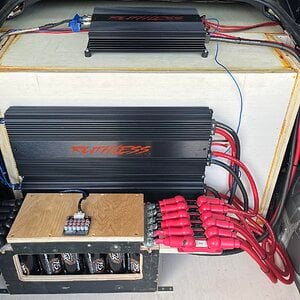You are using an out of date browser. It may not display this or other websites correctly.
You should upgrade or use an alternative browser.
You should upgrade or use an alternative browser.
skadude016 5,000+ posts
CarAudio.com Veteran
skadude016 5,000+ posts
CarAudio.com Veteran
3.6 inch box?
guessing you mean 3.6 cubes? If so that is a little on the small side of port area. I would atleast bump it up to 45-50 sq inches of port //content.invisioncic.com/y282845/emoticons/smile.gif.1ebc41e1811405b213edfc4622c41e27.gif
guessing you mean 3.6 cubes? If so that is a little on the small side of port area. I would atleast bump it up to 45-50 sq inches of port //content.invisioncic.com/y282845/emoticons/smile.gif.1ebc41e1811405b213edfc4622c41e27.gif
spoonraker 10+ year member
CarAudio.com Elite
jellyfish420 10+ year member
i design boxes .......
completely and udderly WRONG. you divide your box in half(on paper) and calculate 1 port per 'box'.Just do the calculations the same way you would for a box with a single port, only the specs of the single port come from two ports added together. Port area, length, and displacement must be added together from each port to get the total.
Ninteens 10+ year member
Senior VIP Member
Thank you!//content.invisioncic.com/y282845/emoticons/graduate.gif.d982460be9f153bb54e5d4cb744f6ae8.gifcompletely and udderly WRONG. you divide your box in half(on paper) and calculate 1 port per 'box'.
only if the box is going to be divided... if its all one open area, the ports need to be calculated together, right?completely and udderly WRONG. you divide your box in half(on paper) and calculate 1 port per 'box'.
eaisest way would be to use a port calculator that allows to figure dual ports
jellyfish420 10+ year member
i design boxes .......
one thing that i just cannot stand, is people spreading mis-information. i'm pretty smart...but if i'm not for positive, i wont guess. i'll let you know.Thank you!//content.invisioncic.com/y282845/emoticons/graduate.gif.d982460be9f153bb54e5d4cb744f6ae8.gif
spoonraker 10+ year member
CarAudio.com Elite
He never said the box had two chambers did he? Or does that not matter? If it does then yeah...I guess I was misinformed along with a lot of people on here because that's where I read it at.
The way I was told is take the NET volume of the entire box. Take the total port area (both ports) and then figure your port length. Divide it in half and each of your ports should be that long...this is for a single chamber box btw, a dual chamber box is obvious....just design two boxes.
The way I was told is take the NET volume of the entire box. Take the total port area (both ports) and then figure your port length. Divide it in half and each of your ports should be that long...this is for a single chamber box btw, a dual chamber box is obvious....just design two boxes.
Trixter 10+ year member
Keepin it Simple
lets see if it works.....i don't believe it will....The way I was told is take the NET volume of the entire box. Take the total port area (both ports) and then figure your port length. Divide it in half and each of your ports should be that long...this is for a single chamber box btw, a dual chamber box is obvious....just design two boxes.
for numbers sake, let use a 4cu' tuned to 30Hz. our ports will be 2 ports each at 2" x 12" so 24sq" each...and 48sq" total...
if you divide the box by the numbers of ports first......
Lv = [(14630000 x 7.64) / (900 x 3465)] - (1.463 x 2.76)
Lv = (111773200 / 3118500) - 4.04
Lv = 35.84 - 4.04
Lv = 31.0
now lets add the port area to get our 48sq" and use the total box volume...
Lv = [(14630000 x 15.28) / (900 x 6912)] - (1.463 x 3.91)
Lv = (223546400 / 6220800) - 5.72
Lv = 35.94 - 5.72
Lv = 30.22
now you say to divide this by 2 and you get...
Lv = 15.11
as you can see the results are very different from each other.
YOU MUST DIVIDE THE BOX BY THE NUMBER OF PORTS FIRST AND FIGURE IT OUT FOR EACH PORT.
jellyfish420 10+ year member
i design boxes .......
very well put. i didn't feel like going that in depth. but now maybe people can comprehend...lets see if it works.....i don't believe it will....
for numbers sake, let use a 4cu' tuned to 30Hz. our ports will be 2 ports each at 2" x 12" so 24sq" each...and 48sq" total...
if you divide the box by the numbers of ports first......
Lv = [(14630000 x 7.64) / (900 x 3465)] - (1.463 x 2.76)
Lv = (111773200 / 3118500) - 4.04
Lv = 35.84 - 4.04
Lv = 31.0
now lets add the port area to get our 48sq" and use the total box volume...
Lv = [(14630000 x 15.28) / (900 x 6912)] - (1.463 x 3.91)
Lv = (223546400 / 6220800) - 5.72
Lv = 35.94 - 5.72
Lv = 30.22
now you say to divide this by 2 and you get...
Lv = 15.11
as you can see the results are very different from each other.
YOU MUST DIVIDE THE BOX BY THE NUMBER OF PORTS FIRST AND FIGURE IT OUT FOR EACH PORT.
if anyone feels like reading heres a good one that tells all about it...
http://mobile.jlaudio.com/support_pages.php?page_id=165
spoonraker 10+ year member
CarAudio.com Elite
Wait...maybe I'm missing something. The two results were only different by seventy-eight hundeths of an inch....is that a big difference?
spoonraker 10+ year member
CarAudio.com Elite
Well after reading that JL tutorial and the examples they provided there is no doubt that you are correct, which I never doubted. I guess the arbitrary numbers we chose didn't end up being a good example //content.invisioncic.com/y282845/emoticons/smile.gif.1ebc41e1811405b213edfc4622c41e27.gif
That's the part that explains why this occurs for anybody wondering. I learned something today.Notice that Method 1 produces the same port length as did our single 4" diamter port as it should (after all, we have the same total port cross-sectional area which this school of thought proclaims is correct!). But the first method is incorrect because it neglects the frictional losses encountered by using many smaller ports--there is a higher port wall surface area to cross-sectional area ratio which raises the total amount of frictional losses in the ports and thus shifts the tuning!
Activity
No one is currently typing a reply...
Similar threads
THANKS i can make that work this really helps big time, appreciate it
- Started by basshead79
- Enclosure Design & Construction
- 2
- 832
Whoa, that will be one skinny port. The width of the back wall ports will be 1.08" wide (27.5mm), but the front port will be shared by 2 subs so...
- Started by MitchnSystem
- Enclosure Design & Construction
- 5
- 745
Assuming the box is made of .75" MDF the 12"x20"x15" box is 1.5 Cu Feet. The 33"x19"x15" is 4.3 cubic feet, something is not right here. JL has...
- Started by Mission Shane
- Subwoofers
- 3
- 756
Recoil 2500.1 $179 2500 x 1 @ 1 ohm. Make sure subs are the dual 4 ohm version.
If you don't want that much power, get the Recoil red1200.1 for 1...
- Started by Ljaudio5281
- General Car Audio
- 4
- 859
You should run all exact matching subwoofers in one singular enclosure and 1 amp or matching amps for the best listening experience for the space...
- Started by bubs
- Amplifiers
- 11
- 1K
About this thread
Latest topics
-
Cost of amp power install kits vs individual products
- Started by kanihoncho
- Replies: 1
-
-
-
OFC vs CCA for wiring amp to car and for speaker use . . .
- Started by kanihoncho
- Replies: 5
-
Suggestions on 6 channel amp/powering 3 way active front stage and driver selection.
- Started by JoeMama541
- Replies: 5


